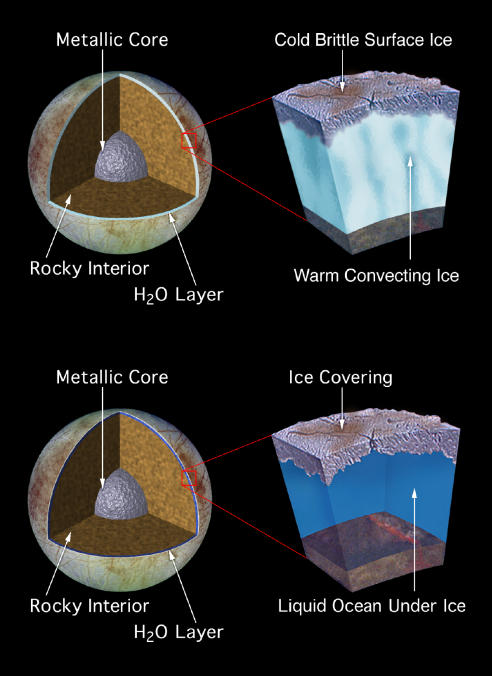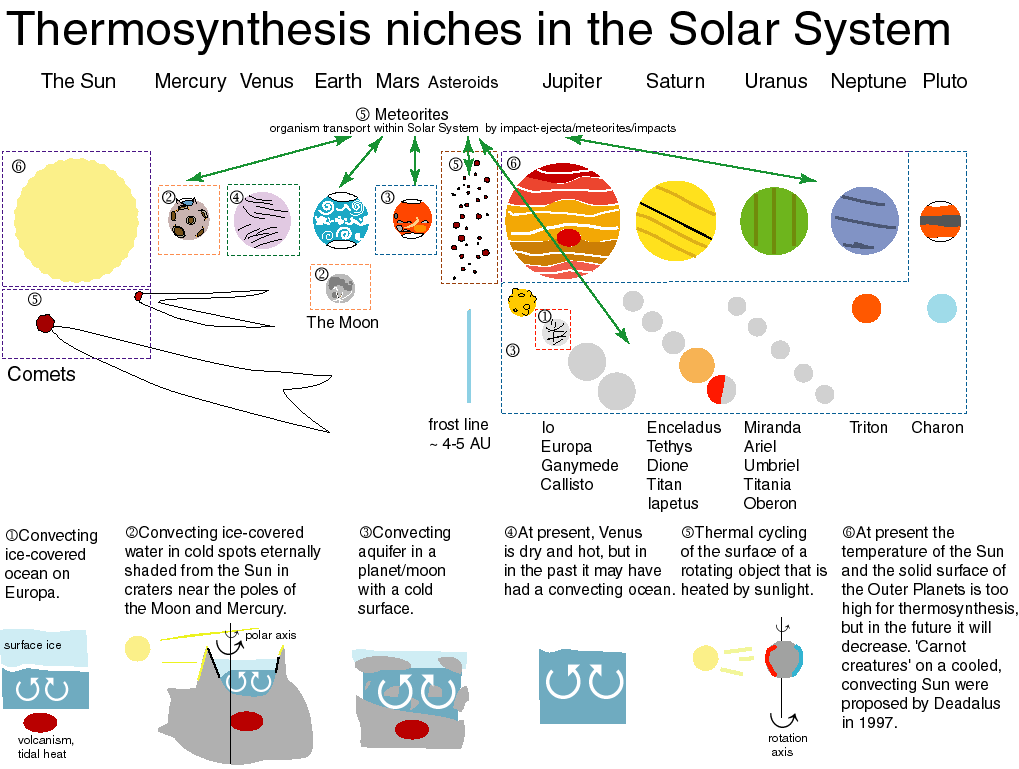| Astronomy Headlines from SPACE.com |
Astrobiology Index

University course on astrobiology: Origin and evolution of habitable worlds
Harold Geller and G. Taylor astrobiology web site at George Mason University
David Darling astrobiology web site
|
General info on exobiology: Astrobiology Index |
||
 |
|||
| : The Electronic Astrobiology Newsletter | |||
|
University course on astrobiology: Origin and evolution of habitable worlds Harold Geller and G. Taylor astrobiology web site at George Mason University | |||
|
Extensive web site on Astrobiology by the author of 'Life everywhere' and
'The extraterrestrial encyclopedia' David Darling astrobiology web site |

|
Extraterrestrial niches for thermosynthesizers |
Many bodies of the Solar System have an ice cover.
The ice may contain old meteorites with the remnants of the very first organisms of the Solar System and may therefore contain fossils of thermosynthesizers.
Mercury
Bill Arnett on Mercury
thinkquest links to data on Mercury
Due to its short distance to the Sun, the surface of Mercury is very hot. At the poles, the crater interiors
are however shielded from the sun and are in eternal shadow.
Such craters constitute cold traps, where
water and other volatile substances condense. Radar has demonstrated the
presence of ice [Slad95,
Harm94].
As this ice may be heated from below by volcanism,
the presence of convecting water is plausible under
this ice, a possible niche for thermosynthesizers.
NASA on ice on Mercury
Venus
Bill Arnett, on Venus
David Grinspoon, author of "Venus revealed"David Grinspoon
The ocean that Venus may have had has now boiled away.
Until it evaporated, this strongly convecting ocean could have
carried thermosynthesizers.
Carl Sagan has proposed life in the clouds of Venus that makes use of cyclic wetting and drying,
a mechanism resembling thermosynthesis.
Life in convecting clouds has been considered [Dimm77,
Dobs00]
CO2 has a low critical temperature and pressure. Much of the CO2 may therefore behave like a fluid, rather than as a gas or liquid. Supercritical CO2 is a good solvent for small biomolecules, and the possibility of life in this semi-ocean should not be excluded.
The Moon
Bill Arnett, on The Moon
Ice has been observed in shaded lunar craters on the Moon, both by radar[
Noze96] and by
neutron fluxes [Feld98].
Just as for Mercury, these craters constitute possible niches for thermosynthesizers.
NASA on ice on the moon
Astronomy Now on ice on the moon
Mars
Bill Arnett, on Mars
At the moment on writing (March 2005) new evidence relevant to the possibility of life on Mars is coming in daily. It is hard to keep track. There may be liquid water just under the surface. In volcanic areas the surface ice may have melted, and convection is plausible. Subsurface aquifers may also contain convecting liquid water.
In the past Mars had an ocean, which may have convected. Under its surface, hydrogen, probably due to water, has been detected: NASA Odyssey mission, Lunar and Planetary Lab, University of Arizona
The Big Outer Planets
Bill Arnett, on the Outer planets: Jupiter
Saturn
Uranus
Neptune
The surfaces of the outer planets are at present too hot to permit life. Microorganisms might be carried along by the cooler clouds, though; thermosynthesis is a plausible energy source for such organisms.
In the future these planets may cool sufficiently to
permit an ocean; here organisms could live on thermosynthesis.
The moons of the Outer Planets
Bill Arnett on the Moons of the Outer planets and Pluto:
Io
Europa
Ganymede
Triton
Titan
Callisto
Pluto
Many moons of the big outer planets are covered with ice.
Liquid water underneath this ice would constitute an environment that could permit thermosynthesis.
A prime candidate niche for thermosynthesizers is the Jovian moon Europa, which contains an ice-covered ocean
that is intensely heated by tidal friction.

INDICATE SOURCE IMAGE
Schulze-Makuch and Irwin have considered energy sources for
organisms in this ocean [Schu01].
Respiration and photosynthesis are considered to be unlikely,
but they do consider heat, in general terms, as a possible energy source:
Thermotrophic life forms may be conceivable that use thermal gradients . . .
and:
A plausible energy-harvesting mechanism would be the presence of membrane macromolecules that
catalyze high-energy metabolites through temperature-dependent conformational changes.
Convection is considered as a distinct energy source as well
[Schu01]:
Directly harvesting the kinetic energy of convection cells or tidal currents
on Europa's ocean floor or ice ceiling would be another way to sustain life in the absence
of light and oxygen.
A complex mechanism for the
formation of high-energy phosphate bonds using convection is proposed but no
combined use of heat and convection as in thermosynthesis.
Obviously, organisms using PTS and MTS would have the described functionality.
| For Saturn's moon Titan the presence of a deep ocean has been proposed: |

|

Because of the possibility of thermosynthesis life is present in almost the entire Solar System. Similarly, the habitable zones around all stars [Huan59], 60, Kast93] can drastically be increased, which increases the chance on extraterrestrial life in the Universe outside the Solar System as well.
The next page constitutes the last page of the Thermosynthesis Home Page: Conclusion.